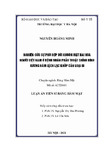
Please use this identifier to cite or link to this item:
http://dulieuso.hmu.edu.vn/handle/hmu/2105| Title: | Nghiên cứu sự phù hợp với khuôn mặt hài hoà người Việt Nam ở bệnh nhân phẫu thuật chỉnh hình xương hàm lệch lạc khớp cắn loại III. (Ngày công bố: 16/03/2021) |
| Authors: | Nguyễn Hoàng, Minh |
| Advisor: | PGS.TS. Nguyễn Thị Thu, Phương PGS.TS. Lê Văn, Sơn |
| Keywords: | 62720601;Răng – Hàm – Mặt |
| Abstract: | Những kết luận mới của luận án: Nghiên cứu theo dõi dọc trên 43 bệnh nhân đã hết tuổi tăng trưởng (18-33 tuổi) sau 12 tháng phẫu thuật, đánh giá đầy đủ sự thay đổi xương, răng, mô mềm và sự ổn định sau phẫu thuật. Kết quả nghiên cứu cho thấy phương pháp phẫu thuật hai hàm mở xương hàm trên toàn bộ theo đường Lefort I và chẻ dọc cành cao xương hàm dưới 2 bên là phương pháp hiệu quả điều trị lệch lạc khớp cắn hạng III do xương. Nghiên cứu đầu tiên ở Việt Nam đánh giá sự phù hợp của kết quả phẫu thuật với chỉ số khuôn mặt hài hòa người Kinh Việt Nam cùng với đánh giá sự hài lòng và chất lượng cuộc sống của bệnh nhân sau phẫu thuật. Đánh giá sự phù hợp của kết quả điều trị với khuôn mặt hài hòa người Kinh Việt Nam trong 37 bệnh nhân nhóm tuổi 18 - 25: Tỷ lệ hài hòa xương là 70,3%; tỷ lệ hài hòa răng là 62,2%; tỷ lệ hài hòa mô mềm là 73,0%. Trong đó, 7 chỉ số hài hòa xương: SNA, SNB, ANB, góc FH-NPg, ANS-Me, N-Me, tỷ lệ N-ANS/N-Me và 5 chỉ số hài hòa răng: Is-NA, Ii-NB, L1-MP, FMIA, U1-L1 là những chỉ số có mối tương quan với hài hòa mô mềm, giúp tăng khả năng đạt được hài hòa mô mềm, tăng hiệu quả phẫu thuật. Qua kết quả nghiên cứu, chúng tôi nhận thấy chỉ số mô mềm là chỉ số quan trọng cần đạt được để có khuôn mặt hài hòa và tăng mức độ hài lòng của bệnh nhân. 7 chỉ số xương hài hòa: SNA, SNB, ANB, góc FH-NPg, ANS-Me, N-Me, tỷ lệ N-ANS/N-Me và 5 chỉ số răng hài hòa: Is-NA, Ii-NB, L1-MP, FMIA, U1-L1 là những chỉ số có ý nghĩa ứng dụng cao trong lên kế hoạch phẫu thuật chỉnh hình xương hàm, giúp tăng hiệu quả đạt được hài hòa mô mềm sau phẫu thuật và tăng chất lượng cuộc sống, mức độ hài lòng của bệnh nhân. New conclusions:This study was a longitudinal study, 43 patients (aged from 18-33) ,who completed growth phrase, were followed 12 months after surgery, which fully assessed skeletal, dental, soft tissue changes and post-op stability. The results showed that bimaxillary surgeries including maxillary Le Fort I osteotomy and bilateral sagittal split osteotomy were effective methods for skeletal class III malocclusion treatment. The first study in Vietnam evaluated the suitability between surgical results and Vietnamese Kinh ethnic’s harmonious face, and the relation to the patients’ postoperation satisfaction level and quality of life after surgery. Evaluate the suitability of treatment results with Vietnamese Kinh ethnic’s harmonious face in 37 patients aged from 18-25: the percentage of achieved skeletal harmony was 70,3%; the percentage of achieved dental harmony was 62,2%; the percentage of achieved soft tissue harmony was 73,0%. 7 harmonious skeletal indexes: SNA, SNB, ANB, FH-NPg angel, ANS-Me, N-Me, and N-ANS/N-Me; 5 harmonious dental indexes: Is-NA, Ii-NB, L1-MP, FMIA, U1-L1 had significant correlation with soft tissue harmony, helped to improve the achievement of soft tissue harmony as well as surgical effectiveness. In conclusion, through research results, we found that soft tissue index played the most crucial role in order to achieve an harmonious face and improved patient’s satisfaction level. 7 harmonious skeletal indexes: SNA, SNB, ANB, FH-NPg angel, ANS-Me, N-Me, and N-ANS/N-Me; 5 harmonious dental indexes: Is-NA, Ii-NB, L1-MP, FMIA, U1-L1 should be applied in orthognathic surgical planning, thus helping to improve the achievement of soft tissue harmony after surgery as well as patients’ quality of life and satisfaction. |
| URI: | http://dulieuso.hmu.edu.vn//handle/hmu/2105 |
| Appears in Collections: | Luận án (nghiên cứu sinh) |
Files in This Item:
| File | Description | Size | Format | |
|---|---|---|---|---|
| 603_00_TVLA_Minh35rhm.pdf Restricted Access | 12.79 MB | Adobe PDF |  Sign in to read | |
| 603_TTLA_Minh35rhm.rar Restricted Access | 1.66 MB | WinRAR Compressed Archive |
Items in DSpace are protected by copyright, with all rights reserved, unless otherwise indicated.